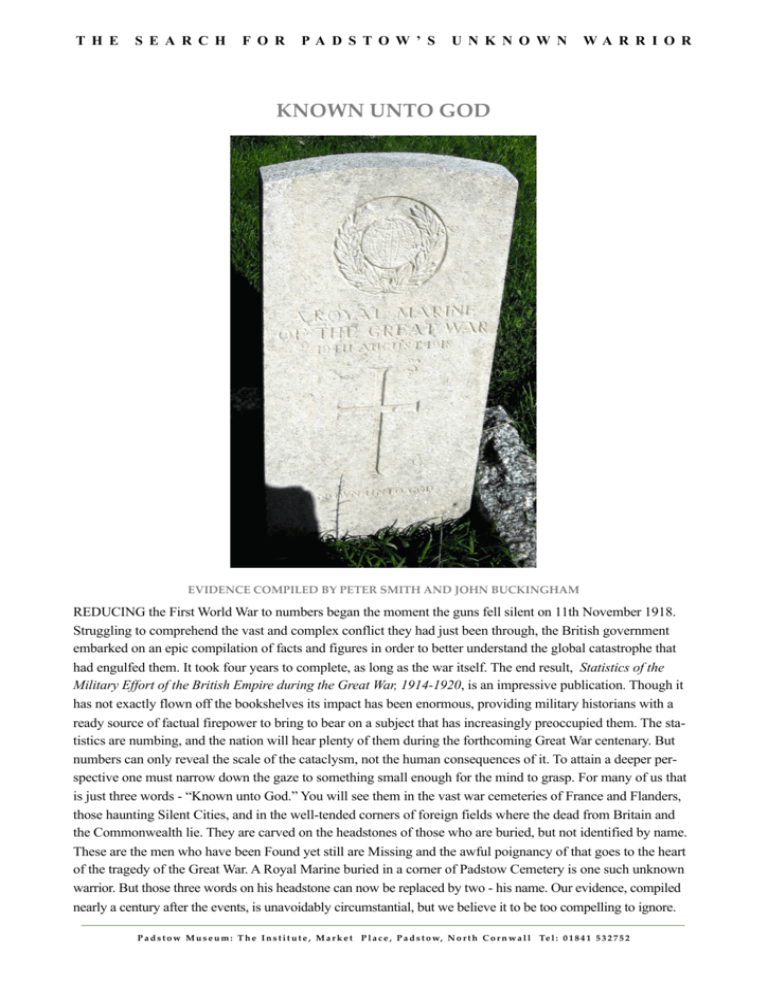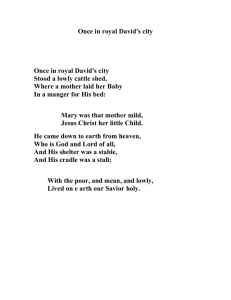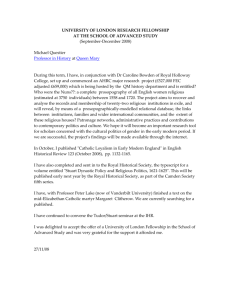to read the amazing story
advertisement

T H E S E A R C H F O R PA D S T O W ’ S U N K N O W N WA R R I O R KNOWN UNTO GOD EVIDENCE COMPILED BY PETER SMITH AND JOHN BUCKINGHAM REDUCING the First World War to numbers began the moment the guns fell silent on 11th November 1918. Struggling to comprehend the vast and complex conflict they had just been through, the British government embarked on an epic compilation of facts and figures in order to better understand the global catastrophe that had engulfed them. It took four years to complete, as long as the war itself. The end result, Statistics of the Military Effort of the British Empire during the Great War, 1914-1920, is an impressive publication. Though it has not exactly flown off the bookshelves its impact has been enormous, providing military historians with a ready source of factual firepower to bring to bear on a subject that has increasingly preoccupied them. The statistics are numbing, and the nation will hear plenty of them during the forthcoming Great War centenary. But numbers can only reveal the scale of the cataclysm, not the human consequences of it. To attain a deeper perspective one must narrow down the gaze to something small enough for the mind to grasp. For many of us that is just three words - “Known unto God.” You will see them in the vast war cemeteries of France and Flanders, those haunting Silent Cities, and in the well-tended corners of foreign fields where the dead from Britain and the Commonwealth lie. They are carved on the headstones of those who are buried, but not identified by name. These are the men who have been Found yet still are Missing and the awful poignancy of that goes to the heart of the tragedy of the Great War. A Royal Marine buried in a corner of Padstow Cemetery is one such unknown warrior. But those three words on his headstone can now be replaced by two - his name. Our evidence, compiled nearly a century after the events, is unavoidably circumstantial, but we believe it to be too compelling to ignore. P a d s t o w M u s e u m : T h e I n s t i t u t e , M a r k e t P l a c e , P a d s t o w, N o r t h C o r n w a l l Te l : 0 1 8 4 1 5 3 2 7 5 2 THE BEGINNING: Two graves, many questions search to uncover the identity of Padstow’s nameless Great War hero began when the curator of the local museum, John Buckingham, sent me an intriguing photograph. It showed two adjacent graves tucked away in a quiet corner of the town cemetery in North Cornwall. Both were the final resting place of a Royal Marine killed nearly a century ago. THE The larger of the two gravestones, a beautiful Celtic cross carved from the local light grey granite, had slowly subsided over the years and now leaned at a precarious angle. On its rough-hewn base was an inscription, picked out in black lettering, which read: “In honoured memory and grateful remembrance of William Moor who lies here, and all others who in the Great War 1914-1918 perished at the enemies hands off this coast.” WHERE COMRADES LIE: Mystery graves in Padstow Cemetery The other headstone, a much plainer affair which was erected by the Commonwealth War Graves Commission, bore no name. All it offered in the way of information was a date the 19th August 1918. John, a local historian who had helped me research the 56 First World War casualties on Padstow’s War Memorial, was keen to discover more about these two Marines. Researching the named man was unlikely to prove too difficult, even though we had no idea how or when he died. But the other man was a different matter. We had little to go on - but both John and I loved a challenge. Early clues RIGHT from the start we assumed the deaths of these men were linked in some way, reasoning, albeit rather unscientifically, that having two Royal Marines buried in a tiny Cornish cemetery within a few weeks of each other seemed something more than coincidence. Researching the named Royal Marine proved straightforward. The CWGC website revealed that he died on 25th July 1918 following a torpedo attack on SS Anna Sofie two days previously. His naval record, also easily found, gave plenty of information on both career and family, not least the fact that the “Moor” on the gravestone should have been spelt with a final “e.” A report in the Cornish Guardian of 26th July 1918 revealed the circumstances of his death and gave us a great description of his funeral at Padstow, a dignified affair which involved local dignitaries, a firing party and a bugler playing the Last Post. William Moore, a 43-year-old veteran from Birkenhead, had been in the service since 1893 and over the course of 25 years had served in a variety of ships and shore establishments. His record was exemplary. Though he had probably started to feel his age by the time the Great War started, Private Moore still managed to be present at the 2 greatest naval battle of the conflict - Jutland on 31st May 1916. He was serving aboard the British battleship Revenge, one of the newest and most powerful vessels in the Royal Navy, and worked one of the main gun turrets with a crew of other Royal Marines. The ship pounded the German High Seas Fleet for more than 90 minutes. Though Revenge suffered no major damage or fatalities Private Moore suffered a slight wound. But there was disappointment over the identity of the other man. All sources on the Anna Sofie attack, including the Board of Trade report to the Admiralty written at the time, said William Moore was the only casualty. This wrecked our theory about the men’s deaths being linked. Sadist of the seas WHILE we were scratching our heads over this setback some interesting facts came to light about the commander of U-55, the submarine which sank Anna Sofie. Kapitanleutnant Wilhelm Werner, who torpedoed the British ship without warning, had apparently already committed one of the worst atrocities of the the war. On 8th April 1917 he sunk the Torrington, an armed merchant steamer. Before sending her to the bottom he took off the 34 crew, lined them up on the submarine’s deck and submerged, drowning them all. The only survivor was the ship’s captain who was made a prisoner. Fours days later Werner repeated his atrocity with the crew of Toro. Werner continued his sadistic spree in 1918, but luck was on the side of his victims. On 4th January he torpedoed the hospital ship Rewa, but the vessel was nearly empty and only four died. On 10th March he attacked another Red Cross ship, the Guilford Castle - but one torpedo was a dud and the other missed. Werner, who sank 63 ships in all, cheated justice after the war by fleeing trial and hiding on a coffee plantation in Brazil. He later returned to the Fatherland where, unsurprisingly, he joined the Nazi Party. Werner died, aged 57, in May 1945 as Germany surrendered for the second time in 30 years. TRAGIC: The Guardian report on Moore Breakthrough OUR search for the nameless Royal Marine had ground to a halt - but then we had a breakthrough. John decided to look up the Anna Sofie sinking in the Shipwreck Index of the British Isles and found a reference to a second casualty, a man named “Gnr Whitmore.” A service record was traced at the National BRUTAL: U-55 captain Wilhelm Werner Archive for a Royal Marine lance corporal named William Whitmore. Though this made no mention of the Anna Sofie, it did indicate that this man had trained as a deck gunner like Private Moore. A barely legible entry said he had been killed in July 1918. This looked extremely promising. An entry for William Whitmore on the CWGC website confirmed he had died on the Anna Sofie on 23rd July 1918. Details of both his parents and wife were also listed. This was a huge step forward - but how were we to prove he was the man in the Padstow grave? The answer came in the Cornish Guardian of 23rd August 1918. A report revealed that the body of an unknown Royal Marine had washed up at Padstow a few weeks after the U-boat attack. There was an account of the inquest, which gave crucial clues to the man’s identity. But it was not until we managed to trace William’s living relatives that we got the evidence we needed to prove that William was the man we were looking for. We also learned a great deal more about the man himself. 3 WILLIAM’S STORY: Family man with a fighting spirit WILLIAM WHITMORE was born at Stoke-on-Trent in Staffordshire on the 21st May 1876. His parents, William and Elizabeth, had one other child, a daughter who they named after the mother. William grew into a handsome, well-built lad and after leaving school he found work as a file maker. But it seems the quiet life was not to his taste and on 28th August 1895 he joined the Royal Marines. William, who was 19, signed up for 12 years. His naval record describes him as 5ft 7ins in height, with a fresh complexion, brown hair and grey eyes. Over the next nine years he served in a variety of ships and shore establishments. While based at Portsmouth in 1904 William, who was then aged 28, got married to Margaret Cook, a slim 17-year-old from Carhampton in Somerset. Later that year they had their first child, a daughter they named Kathleen. The baby was born with a cowl over her face. This harmless thin membrane was thought to be a sign of good fortune and William stitched it onto his Marine belt to protect him from harm. In HAPPY: William and wife Maggie at Kathleen’s christening 1907 his 12 years in the service was up and he found a job in Civvy Street. He also joined the Royal Fleet Reserve. This gave him some much-needed extra income, but it also meant he was obligated to re-enlist in the event of war. In 1910 William and Margaret, or Maggie as he always called her, had their second child, another girl they named Norah. A year later William and his family were living in Salisbury Road in Wellingborough, Northants. He was a blast furnace labourer. To follow where work was available he lived for a time in Doncaster, near to where his sister lived. Three years later he moved to Sheepbridge in Chesterfield. But everything change when the Great War broke out. William rejoined the navy and though he fancied serving in the new submarine service Maggie, anxious for his safety, told him it was too dangerous and persuaded him to rejoin the Marines. William was sent to the Carmania, a former liner converted into an armed merchant cruiser. On 14th September she sunk the armed German liner Cap Trafalgar off Trinidad Island. The shooting from both sides was unrelenting and the Carmania, armed with 4.7ins guns, was struck by 79 shells before she sunk her adversary. William was a hero and sent home a photos of himself standing next to Carmania’s shellblasted superstructure. After repairs at Gibraltar Carmania was sent to patrol the coast of Portugal and the Atlantic islands for the next two years. By the summer of 1916 William’s adventures with Carmania were over and on 5th 4 June that year he returned home. After a short spell at Portsmouth he returned to sea, this time serving on Orvieto,a former passenger liner requisitioned for the war effort. By the time he joined her she had been converted into an armed merchant cruiser. Orvieto spent the next six months on blockade work as part of the Northern Patrol, where she intercepting more than 30 foreign merchantmen. In September 1916 she docked at Glasgow and William left to take a gun-layers course. He was about to join the battle against the U-boat. On 4th February 1915 Germany had declared unrestricted submarine warfare against Britain’s merchant fleet. In retaliation for the Royal Navy’s blockade of the Fatherland the Kaiser’s admirals declared that cargo ships approaching England would now be sunk without warning. It was clear that Britain’s ability to fight the war was now under serious threat and the Admiralty ordered that all merchant ships were to be armed. Many British cargo vessels were being sunk by gunfire from surfaced submarines and HERO: William on the shell-damaged deck of SS Carmania supplying ships with weapons of even a light calibre could deter such attacks. But in 1915 guns were scarce and the process was to prove extremely slow. Arming merchant ships was seen purely as a defensive measure. A captain’s primary duty was to get his cargo to its destination safely, not to engage in offensive action. Admiralty rules of engagement were strict - if a submarine was spotted at distance the ship was ordered to turn and flee. Because of this all deck guns were mounted aft in order that a pursuing U-boat could be targeted more easily. The exception to this rule was when a submarine was sighted close to the ship and just below the surface. In this case the captain was instructed to ram the enemy at full speed. With or without the rules the effectiveness of armament soon became obvious. Between January 1916 and January 1917 U-boats sank 309 merchant ships - of these 235 were unarmed. If finding guns was difficult, finding gunners was more so. Initially Royal Marines were drafted in to help, but by 1917, with the U-boat war at its height, a training programme was set up to teach merchant seamen how to fight the guns themselves. Men of the Royal Marine Artillery and Royal Marine Light Infantry were selected for this training role and William, and other Royal Fleet Reservists like him, were sought out because of their experience. After training these men were sent on active service. As most vessels had one deck gun only two Royal Marine were needed. They were required to become part of the Merchant Service and were paid by the shipowners. In March 1917 William finished his course and both he and Private Moore sailed for Halifax, Nova Scotia on Clan Urquart. The men sailed back to England on Anna Sofie, arriving in February 1918. Five months later the ship would be a wreck on the seabed and both men would be dead. 5 THE EVIDENCE: How events unfolded in 1918 Overview IN the late afternoon of 23rd August 1918 a boat-load of shocked survivors docked at Padstow Harbour. Roughly 70 crew had been picked up from the sea following a submarine attack earlier that day off Trevose Head, a headland on the Atlantic coast five miles to the West of Padstow. Their ship, the armed merchantman Anna Sofie, had been struck by a torpedoed without warning and had gone down four miles West of Trevose. Most of the men had escaped unharmed, but a Royal Marine serving onboard was in a bad way. Private William Moore, who helped operate the ship’s 4ins aft-mounted deck gun, had suffered torpedo blast injuries to his abdomen and was barely conscious when he was brought ashore. Too sick to be moved very far, the man was transported by cart to the Royal National Mission for Deep Sea Fishermen in the town. Padstow physician, Dr William Sargent, was called, but he found that little could be done and after two days of agony Private Moore succumbed to his injuries. An inquest held two days later was told that the Marine had died of acute traumatic peritonitis. On Sunday 28th July Moore was buried with full military honours at Padstow Cemetery. Nineteen days later, on the 16th August, the body of another Royal Marine washed up at Tregudda Gorge a few miles from Trevose Head. The dead man was found to be badly decomposed and the body was taken into town. An inquest was held the following day, but no evidence as to the dead man’s identity was offered. On 18th August townsfolk gave this unknown casualty of war a full military funeral and laid him to rest beside the freshly-dug grave of Private Moore. DEADLY: (Left) U-boat Alley with Trevose Head ringed. (Centre) Padstow coastline. (Right) Tregudda Gorge How the body was found AT 1.30pm on Friday 16th August 1918 Corporal Grigg of the RAF was strolling along the cliffs above Tregudda Gorge when he spotted something in the sea 200ft below. Unsure what it was he called over a Boy Scout who happened to be using a pair of binoculars nearby. Taking a closer look the corporal realised the object was a man’s body. The alarm was raised and PC Jenkin from Padstow was quickly on the scene. With the aid of ropes and the help of several other RAF men the body was recovered and taken back into town. Clues from the inquest THE following day an inquest took place before a coroner and jury in Padstow. Giving evidence, the police constable said that when the body was recovered it was found to be badly decomposed. A lifebelt was still fastened in place. When it was removed a label on it read “Birt and Son, Shipping, London.” The dead man was wearing a military vest, which bore a distinctive broad arrow on it, and a pair of trousers. The three trouser buttons were embossed with the words “Royal Marine Light Infantry.” The man 6 was practically bald and the right side of his face was cut. There was a tattoo on the man’s left forearm which appeared to show the letter “M” with the figure of a lady. This arm was found to be broken. PC Jenkin estimated the dead man to be about 40 years of age and roughly 5ft 10ins in height. The coroner asked the witness how long the body had been in the water and the constable estimated that to be roughly eight to ten days. The officer found no clue to the man’s identity. The coroner and the jury, all local men, would have been well aware of the submarine attack on the Anna Sofie on 23rd July. They would also have known that a Royal Marine from that vessel had arrived with the rescued survivors and had died of his wounds two days later. Some amongst them may even have been present when the man had been buried in the town cemetery. Their job, however, was merely to ascertain how the this unknown man died. The jury returned their verdict: “Found Drowned.” THE PROOF: Naming the Unnamed Warrior Our method THE aim is to prove that the body found at Tregudda Gorge on 16th August 1918 and which was later buried in an unnamed grave at Padstow Cemetery was William Whitmore. We will demonstrate this in several ways. Firstly, a detailed analysis of Royal Marine fatalities will show that Lance Corporal Whitmore was the only man whose body could have washed ashore at Tregudda Gorge. This will be substantiated up by the reactions of local people at the time and also evidence given by the constable who recovered the body from the sea. This shall be further endorsed by a letter written by the last man to see Whitmore alive which offers confirmation that the lance corporal was the man who later washed up on the Cornish coast. We will also show that descriptions of the body given to the inquest match details found in William’s naval record. Lastly, and perhaps most crucially of all, we will produce testimony from Whitmore’s direct descendant which proves beyond any reasonable doubt that he was the unknown Royal Marine who was buried in Padstow Cemetery. Analysing the dead WE decided to try and identify the dead man at Tregudda Gorge by conducting a detailed study of all Royal Marine casualties over the relevant period. We ruled out deaths prior to May 1918, reasoning that any body that had been in the sea before then would have been far too badly decomposed to be the dead man at Tregudda. So our start point was 1st May and our end point was 16th August when the body was found. The total number of Royal Marine fatalities between these two dates was 189 worldwide. Sixty of these were killed or died of wounds on the Western Front and were discounted, leaving 129. Of these men 78 died of illness, most of them victims of the Spanish Flu pandemic which was then reaching its height, and a further 23 died accidentally or of natural causes. This left 28 Royal Marines, all of whom died as a direct result of the war. Ten of these died of wounds following their involvement in the Royal Navy’s Zeebrugge Raid on 23rd April 1918. Eighteen fatalities now remained to be considered. Of these men three were ruled out immediately as one was killed in Lemnos, another in the UK and the third died of wounds following a sinking in July 1917. Fifteen Royal Marines remained. These men were all deck gunners who died in U-boat attacks on nine ships. Three attacks took place in the Mediterranean and the five men killed were discounted because of the location of the sinkings. A fourth attack occurred off the French coast and the two Marine fatalities were also ruled out for reason of geography. This left eight men, all of whom died in five attacks in home waters. Two Royal Marines were lost on 25th June when SS Moorlands, an armed merchant vessel, 7 was sunk by UB-88 in the North Sea. Due to the locality of this sinking on the East coast these men were crossed off the list of possibles. The remaining four attacks, involving six Royal Marines, took place off the West Coast of England. We looked at all of these deaths more closely. On 6th May 1918 SS Sandhurst, an armed merchant vessel, was sunk in North Channel, the strip of sea between Northern Ireland and Scotland. Private Frederick Heard, RMLI was one of those who vanished into the sea. Though it is feasible his body drifted 300 miles South and washed up at Tregudda Gorge it is highly unlikely. The body would have been in the sea for more than three months by the time it arrived on the Cornish coast and the state of decomposition would have been well advanced. It would also have taken a fearful battering on its long journey South. This body would have been an awful sight and does not sound like the dead man PC Jenkin described as being in the sea for “eight to ten days.” This man was ruled out. WRONG: Button of RMA men on Saima DOOMED: As Anna Sofie went down William leapt into sea RIGHT: RMLI button as worn by William On 8th July another Royal Marine, Private George Mawhood, went missing after SS Ben Lomond was torpedoed and sunk 30 miles south-east of Daunts Rock off Southern Ireland. Though this man was much nearer Cornwall he was still more than 160-miles from Tregudda. His body, a prey to wind, tide and current, would have had to make an extremely unlikely journey across the Irish Sea’s natural north-south flow to reach the required spot almost directly East from where it entered the water. Though Mawhood’s body would not have been in such a bad state of decomposition as the previous case we considered that it would nevertheless have been too extreme to fit the constable’s description of the body at the inquest. This left four men, all of whom died in the waters West of Trevose Head. This stretch of sea was one of Britain’s main shipping routes and became the haunt of prowling German U-boats during the Great War. In four years 25 cargo ships and 27 fishing boats were sunk here, earning it the nickname “U-boat Alley.” Two of the four remaining men were aboard SS Saima, which sank ten miles West of Trevose on 8th June. It would appear that either of these individuals could have been the unknown man at Tregudda Gorge except for one small detail revealed in the inquest evidence. PC Jenkin said buttons found on the dead man’s trousers had the words “Royal Marine Light Infantry” on them. But both gunners on Saima served in the Royal Marine Artillery and would have worn buttons with those words on them. They were both ruled out. The last two men on our list died in the U-55 attack on Anna Sofie on 23rd July 1918. One was Private William Moore, who now lies in Padstow Cemetery beneath a headstone that bears his name. The other was Lance Corporal William Whitmore, who we believe lies next to him in an unmarked grave. Local knowledge THOUGH the identity of our unknown Royal Marine has been revealed by painstaking deduction, plain commonsense would have served us just as well. The Anna Sofie sinking was the most recent attack in the area by quite some distance and it also went down closest to Trevose Head - just four miles. It was therefore the 8 right ship, in the right place, at the right time - and the only casualty that was unaccounted for from this vessel was William Whitmore. The townsfolk of Padstow were well used to the sea giving up its dead - with the infamous Doom Bar sandbank a few miles from the harbour mouth how could they not be. Over the centuries the bodies of many shipwrecked seamen, and more than a few brave lifeboatmen who went to their aid, have washed up along their beaches. Local fishermen knew the sea well and understood the currents that swirled around their native shores. So when on 16th August the body of an unknown Royal Marine was found at Tregudda Gorge, a breathtaking natural fissure swept by waves, they must have known instantly where it had come from. Survivors from the U-boat attack on 23rd July would have told them their ship had been torpedoed four miles off Trevose Head and Tregudda, a few miles north-east along the headland, would have been a natural place for debris and bodies to have come ashore. Though Padstonians had no idea who the dead man was common sense would have told them he came from the Anna Sofie and for this reason they buried him next to the other known victim of the attack, fellow Royal Marine William Moore. It is our believe that the townsfolk of Padstow assessed the situation correctly PC Jenkin’s evidence BUT what of PC Jenkin’s evidence? The officer claimed that the body he found had only been in the sea for eight to ten days. If the officer was right in his estimate - and it was only an estimate - then the dead man would have had to have gone into the sea around 6th August. There were no local sinkings on this date. The only ship attacked in the area around this time was the Anna Sofie, thirteen days earlier. The next closest attack was the Saima on 8th June, which was forty-five days earlier still. Though the PC’s estimate was wide of the mark it is still useful, for whilst it is possible he could have mistaken a 23-day-old body for a ten-dayold one it is highly improbable that he would have made the same mistake with a 58-day-old one. If anything the officer’s testimony substantiates the claim that the body recovered from Tregudda Gorge could only have come from the Anna Sofie - and therefore could only have been William Whitmore. Last man to see William alive THOUGH there has been some confusion over the number of casualties from the Anna Sofie attack this has been cleared up once and for all by a first-hand account of the attack written by the last man to see William Whitmore alive. Shortly after the sinking his widow wrote to one of the survivors asking him what had happened to her husband. The man, a ship’s steward named Wilkinson, replied on the 2nd August, ten days after the attack and two weeks before the unidentified body washed up at Tregudda Gorge. CLUES: Cornish Guardian report on Whitmore 9 It read (with its original spelling) as follow “It is with Deepest Regret I write in answer to the owners letter & yours I received this morning. I was Steward on Board of the S.S. Anna Sofie at the time when she was sunk by the Enemy, it accured on 23 July at 2.30 in the afternoon & we were off Trovose Head Cornwall. & your husband was asleep at the time with the other gunners. & your husband got on deck & then jumped overboard & I went after him & after we swam a good distance from the sinking ship he called me & I went to his assistance & when I got where he was he had disappeared & I myself was taken out of the water a long time afterwards by a patrol Boat unconsious & landed at a little Place called Padstow Cornwall & put in hospital with other three of the Crew the second gunner included, in the gunners case his injuries were internal & he Passed away on July 25 & was Buried with all Military & Naval honors on Sunday 28. But Madam I may say for sure I was the last one who saw yours Dear Husband alive & There was a fair Big Sea running at the time & there is no Doubt but he has gone to his Eternal home & Rest with My Deepest Sympathy with you & his Dear Children. This graphic account must have had a devastating impact on Mrs Whitmore, a 31-year-old mother of two young daughters, but it is also significant because it establishes two important facts: 1. L/Cpl Whitmore was aboard the Anna Sofie 2. His body did not go down with the ship. It also revealed that William was asleep below when the torpedo struck and would only have had time to pull on his lifebelt before leaping into the sea. This explains why he was only wearing a vest and trousers when his body was found at Tregudda. The naval record WILLIAM’S record of service in the Royal Marines and the Royal Fleet Reserve is a long and exemplary one, beginning with his enlistment on 28th August 1895, extended through 23 years of unblemished duty, and ending four miles off Trevose Head in the final year of the Great War. But it is to the more mundane section of his service record that we must turn to help us identify the unnamed Royal Marine at Padstow Cemetery. During the inquest PC Jenkin gave the coroner and the jury a physical description of the dead man he found at Tregudda Gorge. He said he thought the man was about 40 years of age and 5ft 10ins tall. He said he also had a tattoo on his left forearm. This description matches that found on William’s Royal Marine service record which states that he was 42 years old, was roughly 5ft 8ins in height and had a tattoo on his left forearm. The tell-tale tattoo A TATTOO on a Royal Marine’s arm is not in itself unusual, but there was something distinctive about the one PC Jenkin found on the body at Tregudda. As mentioned previously the design was composed of the letter "M" together with the figure of a lady. This obviously suggested a romantic theme. William Whitmore’s tattoo was similarly romantic and the story behind it has been passed down the family over the years. Isabel Pope, William’s grand-daughter, remembers her redoubtable grandmother, who lived to be well over 90, explaining how it had come about. “She told me that both she and William wanted a token of their love for each other to remain with them always,” she said, “They decided to put a tattoo on each of their left arms, the side nearest to their heart. William did them both himself by scratching them on with ink. My grandmother’s tattoo depicted a Royal Marine, but no-one in the family recalls exactly what William’s was like.” But it is not difficult to picture these finished tattoos. The name of William’s wife was Margaret, though he always called her Maggie. Whilst her tattoo would have shown the figure of a Marine with the letter “W” - his would have shown the figure of a lady with the letter “M.” William could not have guessed how crucial his love token would prove to be nearly one century on. 10 THE AFTERMATH MARGARET Whitmore was told her husband was the only fatality of the Anna Sofie attack, a curious reversal of contemporary records in which Private Moore was the only casualty mentioned. Details were understandably scarce as to what had happened to William, but unwilling to let the matter rest Margaret tracked down a survivor and wrote to him asking for information. His reply, quoted in full above, dashed any faint hope she may have clung to that her missing spouse could still be alive. In the weeks that followed the War Office asked Margaret to view several bodies found washed up around the Cornish coast, but none were her William. In the end she gave up making these agonising visits to the West Country. As has been shown William’s body ended up at Tregudda Gorge nineteen days after the sinking and was buried two days later. Whether Margaret was aware this body had been found is not known. In any event, it is unlikely she would have had time to see it before the funeral. The years after the tragedy must have been hard for Margaret as she struggled to bring up her two small children on the small gratuity granted her for the death of her husband. She did find some happiness, however, when in 1924 she married again. But she would never forget the Royal Marine she loved and lost and stories of their time together would be told by Margaret until her death in Chesterfield in 1978. Isabel Pope, the daughter of William’s first child Kathleen, recalls how these stories kept the memory of her courageous grandfather alive. News that his grave has almost certainly been found is bitter sweet for her. “I wish my mother had lived to see it, ” she said. Sources Many thanks to Isabel Pope and other Whitmore family members for their memories and photographs Padstow Museum National Maritime Museum, Greenwich Commonwealth War Graves Commission Cornish Guardian 1914-1918 Royal Navy Service Record of William Whitmore R.M. Registration of Documents of the Anna Sofie, Lloyds Register No.102747 Board of Trade/Admiralty Return of Losses 1918 (ADM1/8547/335) Board of Trade BT 334 relating to the death of William Whitmore Anna Sofie Crew Agreement (ON 102747), Maritime History Archive, Memorial University, Newfoundland naval-history.net (Royal Marine deaths 1st May - 16th August) uboat.net (submarine activity WW1, biographies of U-boat commanders) 11





